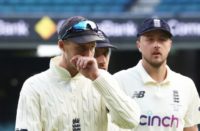There is pace that hurries batsmen and then there is real pace that threatens their well-being, and Tymal Mills possesses the latter in all its bone-crunching glory.
Fast bowling that quick, and we are talking between 90-95mph, cannot really be coached. Which is just as well because Mills, who was born in Dewsbury but grew up near an American airbase in Suffolk, did not really get any coaching, at least not when it would be of most help, which is between the ages of 10-15.
Coming to cricket late, as he did at the age of 14, can be a mixed blessing.
It can mean you come to something like bowling without the usual strictures that coaches apply, which can be a good thing in our overly prescriptive modern world.
But not having a grounding in the sport can hinder too and Mills, for all his natural talent at bowling left-arm quick, does not yet think like a cricketer, something that has proved an impediment as he has climbed the ladders of the game.
Not having a developed cricket brain – Sajid Mahmood was similar in that regard – certainly hampered his progress at Essex, the county that discovered but did not really develop him. He now plays for Sussex, in white ball cricket only, after it was discovered that he had a rare back condition which limits the amount of overs he can bowl.
That is a triumph. A year ago, after joining Sussex, his career in cricket looked over as medical experts pored over his injury problems puzzling to discover what was wrong. After testing for many serious conditions they surmised he suffered from a narrow spinal canal, something that could affect his mobility in later life if overstressed now.
Despite his problems, he can still bowl quick. Measuring devices at Loughborough, where the England and Wales Cricket Board’s Performance Programme is based, have clocked him and Stuart Meaker as the fastest of any in the past ten years, at 89mph. If that doesn’t sound that fast, their method takes the average speed of the ball’s journey down the length of the pitch.
By contrast, TV speed guns measure the release speed only, when the ball is at its quickest. According to that method, Mills uprooted Chris Gayle’s leg-stump last week with one travelling at 93mph.
Although Mills is adding variation to his bowling, his default is raw pace.
In a colourful description, Kevin Shine, the ECB’s fast bowling coach, says that whenever he takes balls from Mills in his mitt, off any kind of run-up, they have “flames coming out of the back of them”. And Shine was pretty quick himself.
Mills’ pace, while well known to Essex followers, became more widely acknowledged when England played the county in a warm-up for the 2013 Ashes. On a slow, dead pitch at Chelmsford, he gave England’s batsmen a working over they did not forget quickly, especially Graham Swann, who took a nasty blow on the arm. Others came off just as battered. It got him a job as England’s net bowler in Australia that winter, his doppel-ganger of Mitchell Johnson proving painfully accurate judging from the bruises England’s batsmen suffered in the nets.
His speed got tongues wagging but Essex’s template for success in red-ball cricket at the time (not that it proved overly successful) was to produce grassy pitches for David Masters to bowl accurate seam on, two things (the accuracy and to hit the seam regularly) Mills could not guarantee.
When he did play he was not handled well on the field, especially in terms of field settings. At his pace, a third man is not only a run-saving necessity but a wicket-taking option as well, but he rarely had one. It all came to a head in a four-day match against Northamptonshire where his lack of control, and he was not the only one to err looking at the bowling figures, contributed to Essex losing the match. That match was in mid-April after which he played three more Championship matches over the remainder of the summer.
Despite that, Essex recognised him as the kind of talent you don’t see often and wanted him to stay. But Mills told them, and he made no bones about this, that he would sign for the best payer and while Essex were allowed to compete, that ended up being Sussex.
If that makes him sound mercenary, nothing could be further from the truth. For most of his career the odds have been against him succeeding. After Essex discovered him playing club cricket for Mildenhall in Suffolk, he would catch four buses just to get to indoor nets at Chelmsford in the winter and four buses back. Not unusual 70 years ago, maybe, but rare in this age.
It was only after the move to Sussex, and despite his medical problems, that his white-ball bowling progressed to the point where England see him as a T20 asset.
Physical problems like his can be useful at focusing the mind and the fact that his career has been refined to making a statement over 24 balls each match means that he now has to make every ball count. Even his training is geared towards what scientists would call “big impact low frequency events,” the onus being on brief intensity.
The physiologists at Loughborough say he has, save for his back defects, the perfect means to bowl quick, having a powerful, muscular physique and elastic joints. Athletic for someone of his build, he has a nice rhythmic run before his left-arm unleashes its thunderbolts. Better control is coming, as well as the ability to bowl swing and slower balls, both of which will make him more of a handful than he already is.
His gift, or unique-selling-point in modern parlance, is that he can bowl quicker than 99 per cent of pace bowlers in history, and that is what makes him special. Neither he, nor any captain he has from now on, should forget that.
This piece originally featured in The Cricket Paper, Friday June 17 2016
Subscribe to the digital edition of The Cricket Paper here












